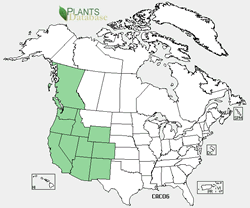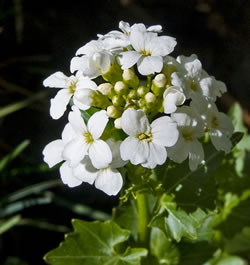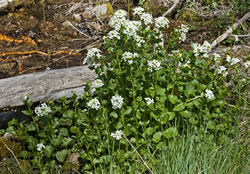Plant of the Week
 Cardamine cordifolia range map. USDA PLANTS Database.
Cardamine cordifolia range map. USDA PLANTS Database.
 Close-up of Cardamine cordifolia from Provo Canyon, Utah. Photo by Steve Hegji.
Close-up of Cardamine cordifolia from Provo Canyon, Utah. Photo by Steve Hegji.
 Cardamine cordifolia along edge of Big Springs Trail, Provo Canyon, Utah. Photo by Steve Hegji.
Cardamine cordifolia along edge of Big Springs Trail, Provo Canyon, Utah. Photo by Steve Hegji.
Heartleaf Bittercress (Cardamine cordifolia)
By Walter Fertig
The genus Cardamine of the mustard family (Brassicaceae or Cruciferae) contains approximately 170 species worldwide, of which 50 occur in North America. Known as bittercresses or toothworts, most species of Cardamine can be recognized by their deeply three-parted or pinnately divided leaves and slender, elongated fruit pods. Heartleaf bittercress (Cardamine cordifolia) is unusual in having leaves that are simple or undivided with wavy lobes and heart-shaped bases (cordifolia translates as heartleaf in latin). As is typical for all mustards, Heartleaf bittercress has flowers with four petals arranged in a cross, inspiring the name “Cruciferae” for the family. The flowers of Heartleaf bittercress are bright white and large, while other bittercress species have pinkish blooms or much smaller flowers.
Heartleaf bittercress typically grows in wet soils along streams, ponds, and lakeshores from British Columbia, Idaho, and Wyoming to northern Arizona and New Mexico. Populations are often locally abundant in moist, shady forests. Recent studies have found that insect herbivory is significantly higher on Heartleaf bittercress populations found in open, sunny sites than those in shady areas and that given protection from insects plants will grow more vigorously in the open. In most mustards, the presence of sulfur and nitrogen containing glucosinolates (also known as mustard oil) helps reduce herbivory and imparts the family’s characteristic sharply bitter taste. High doses of mustard oils can be toxic, but a number of moths and other insects have evolved metabolisms to counter-act the chemicals. Some mustards also naturally possess lower concentrations of mustard oils or have been bred for their palatability.
Bittercress flowers and young leaves are edible to humans and have a tangy, horse radish-like taste (this becomes increasingly bitter as the leaves mature). Superficially, Heartleaf bittercress resembles Watercress (Rorippa nasturtium-aquaticum), a much shorter, introduced species with smaller flowers found commonly in wetland areas across the United States. Care should be taken in sampling either species in the wild, as they often grow near stagnant water that can harbor liver flukes and other disease-causing parasites.

